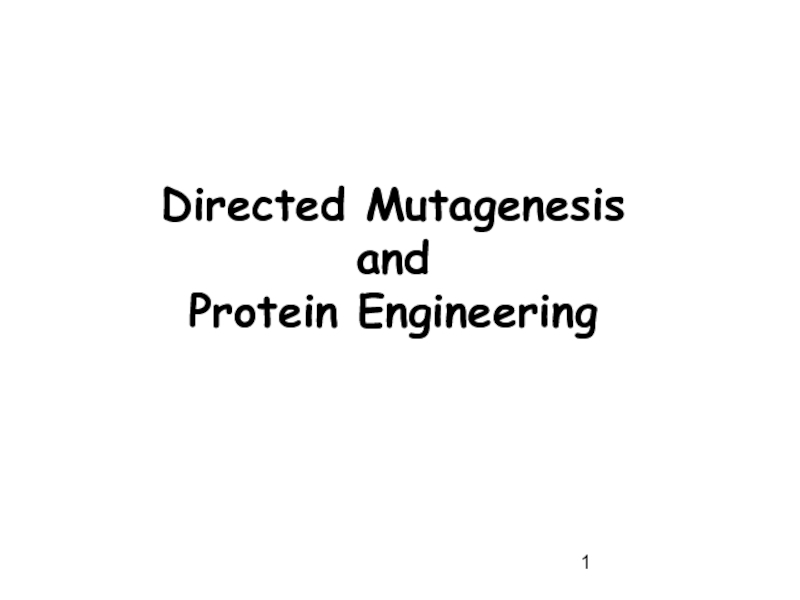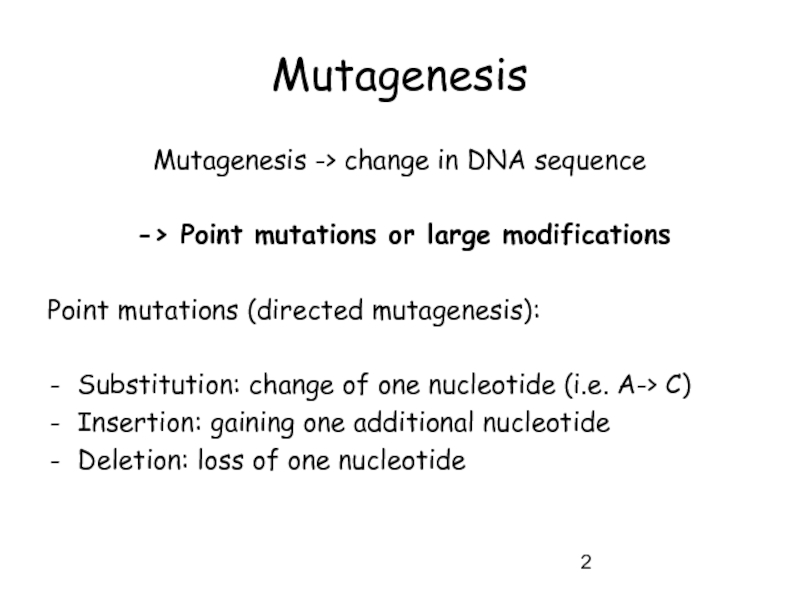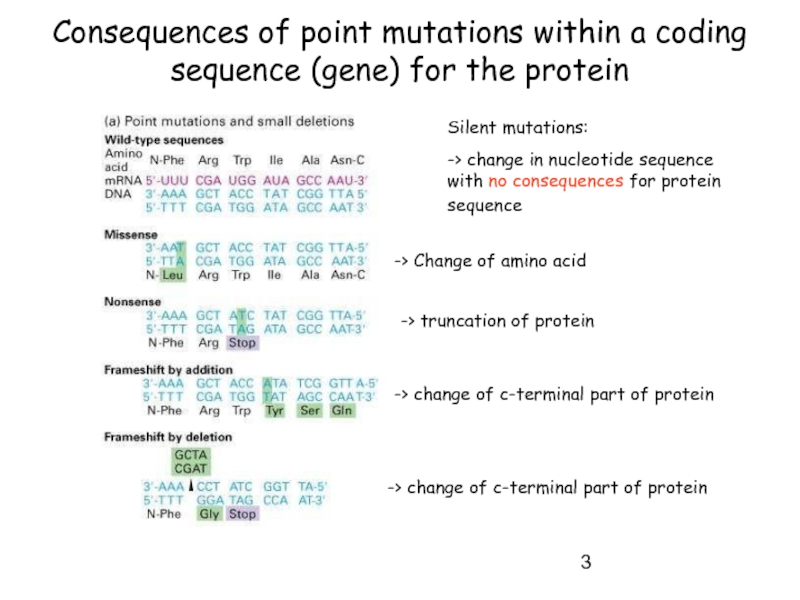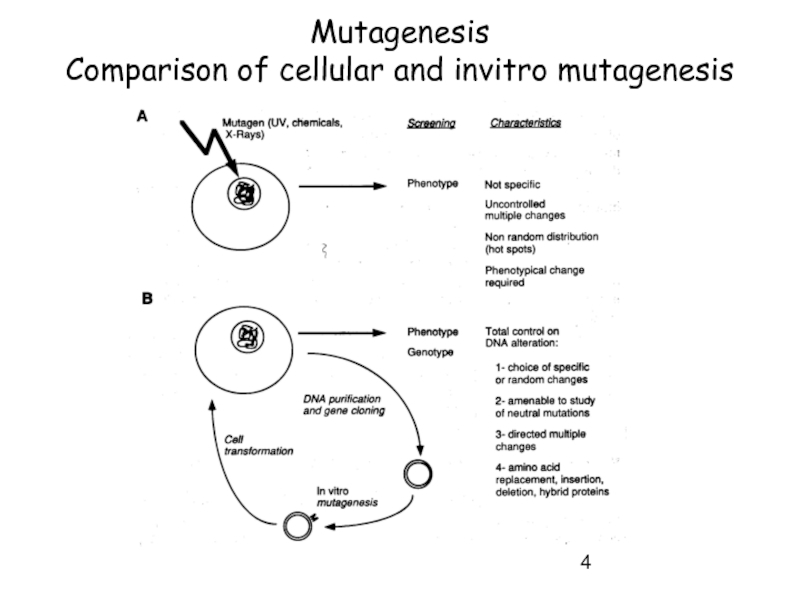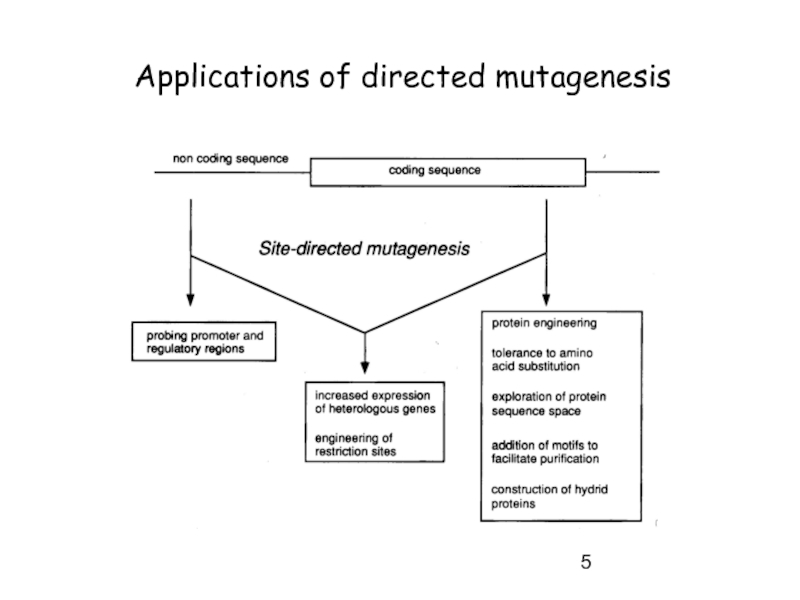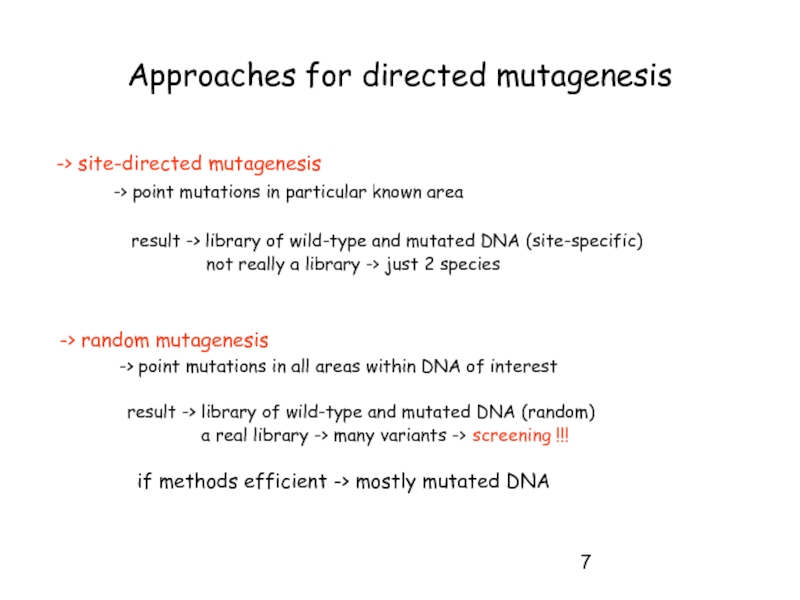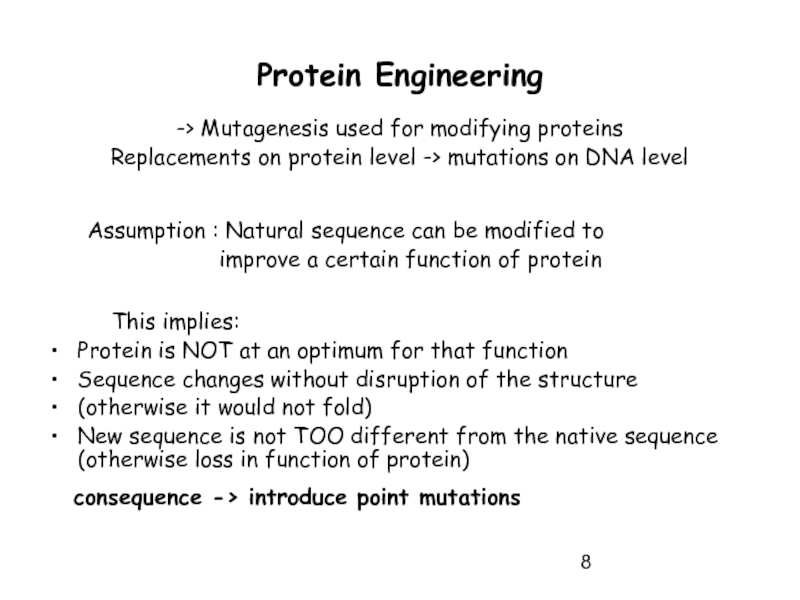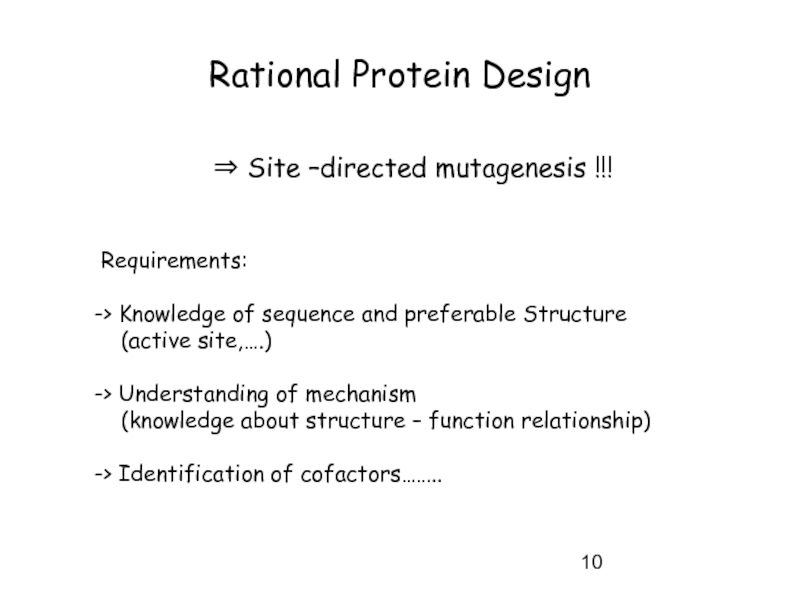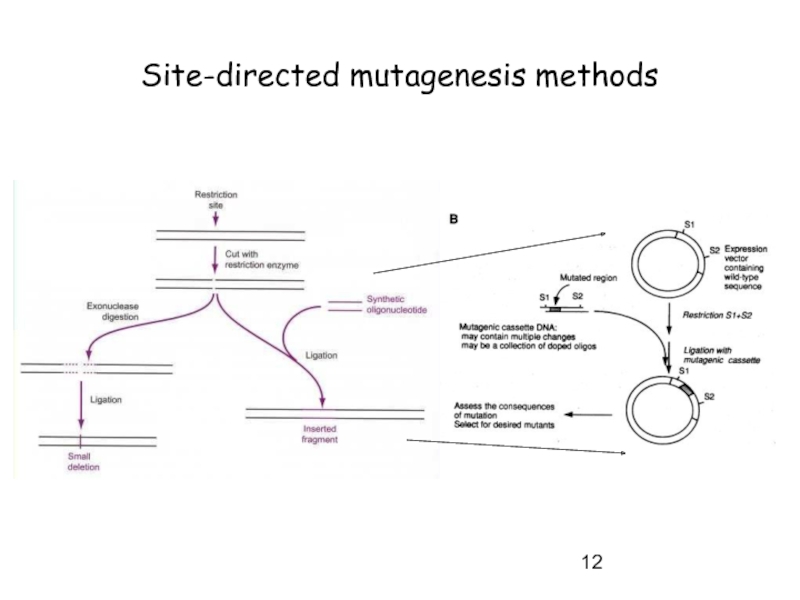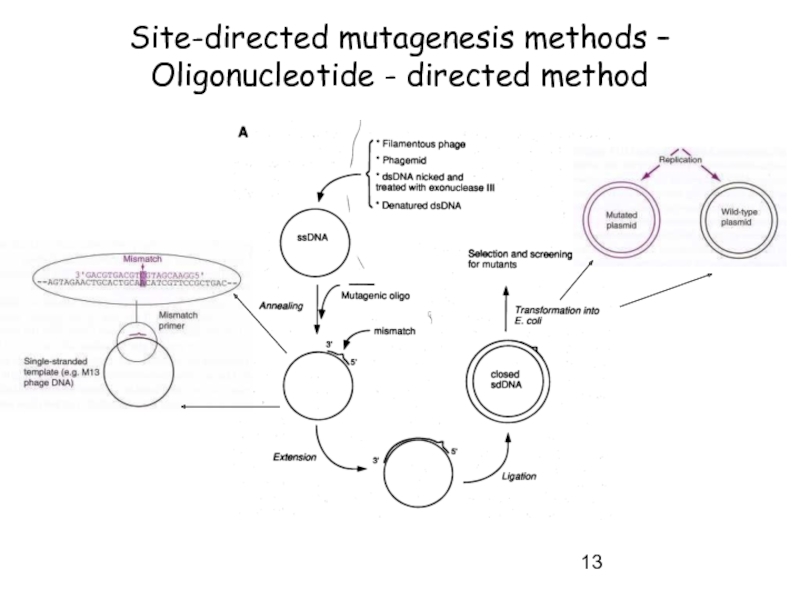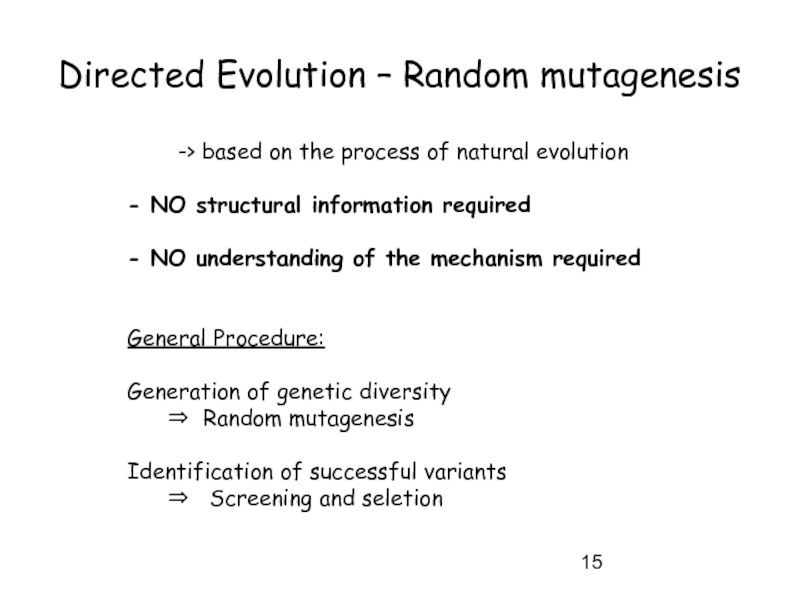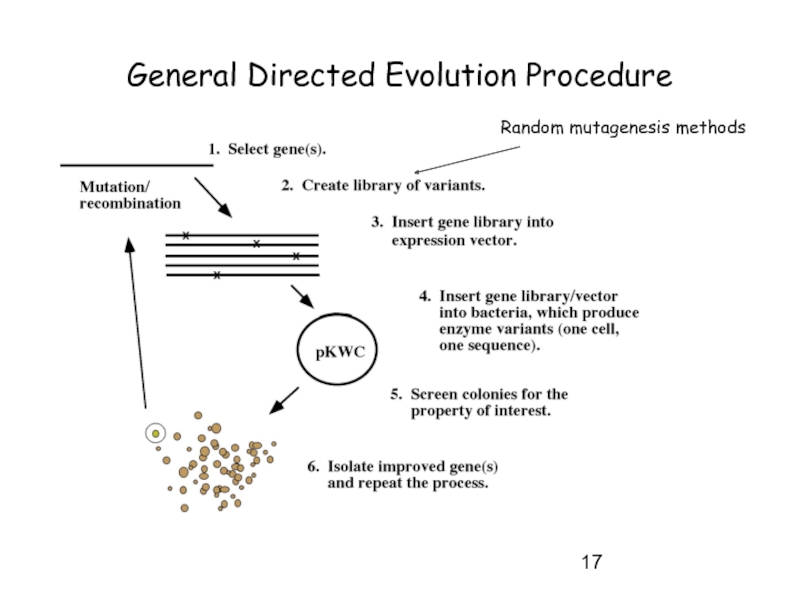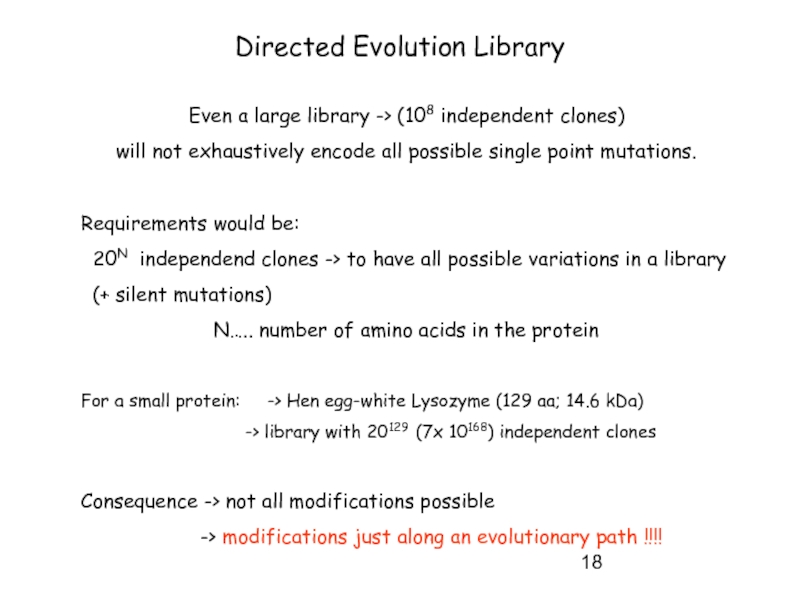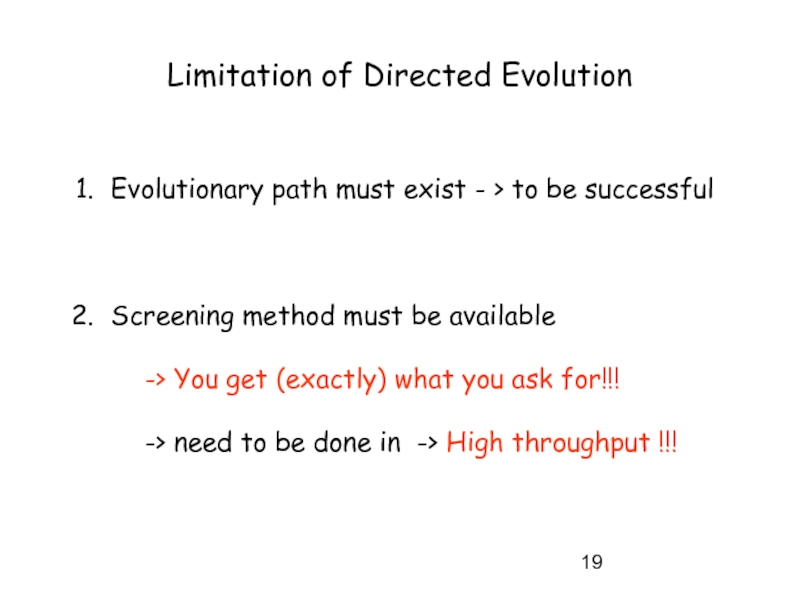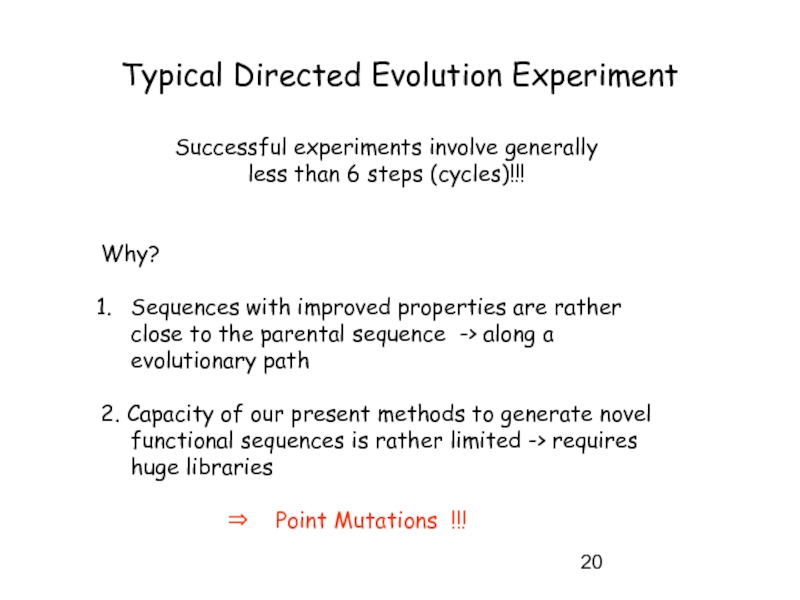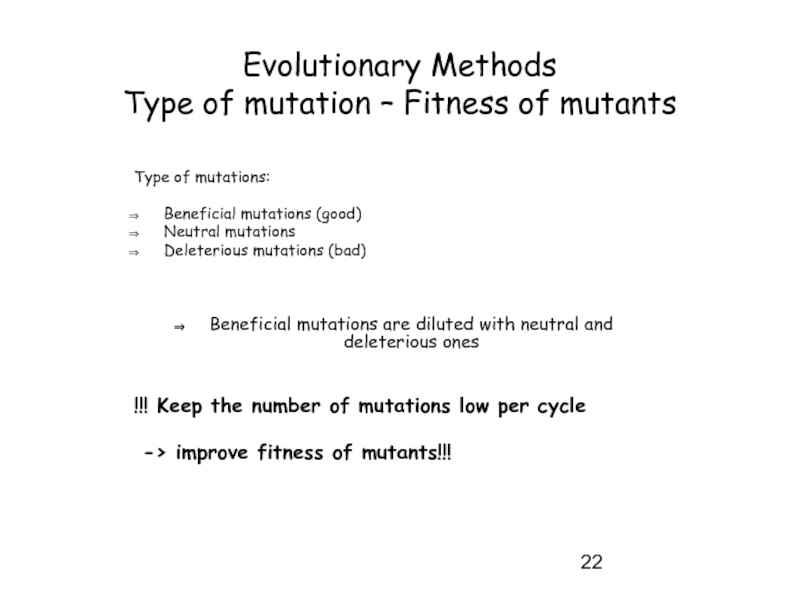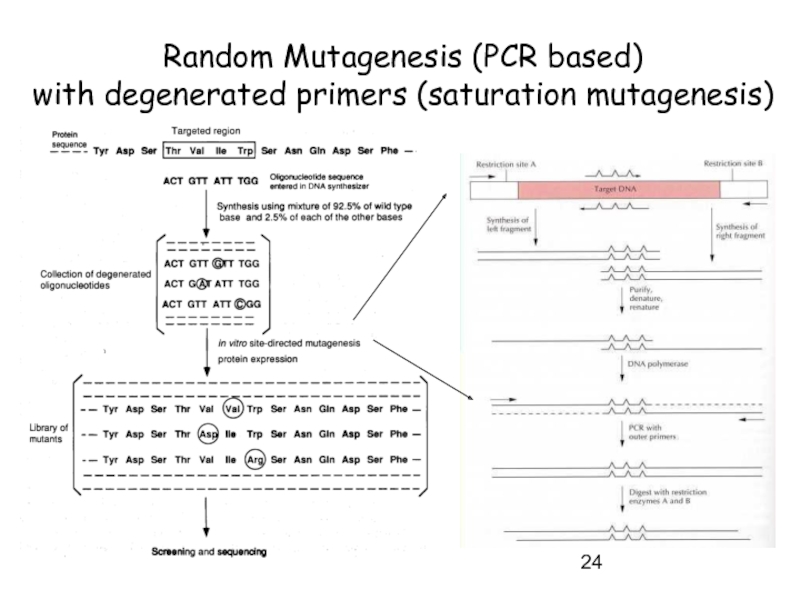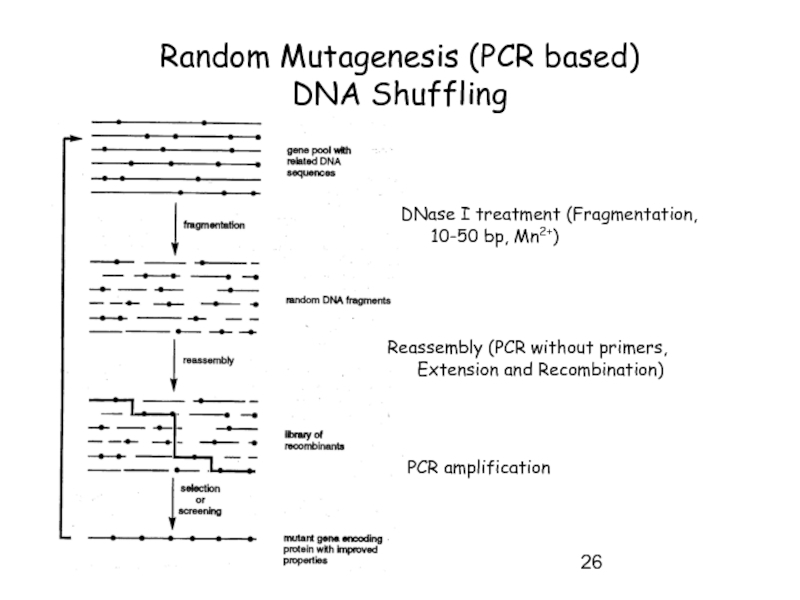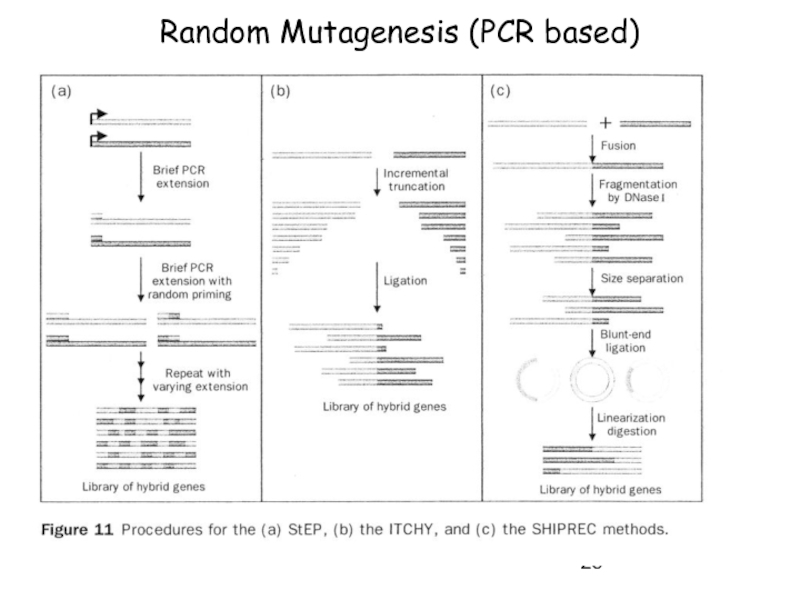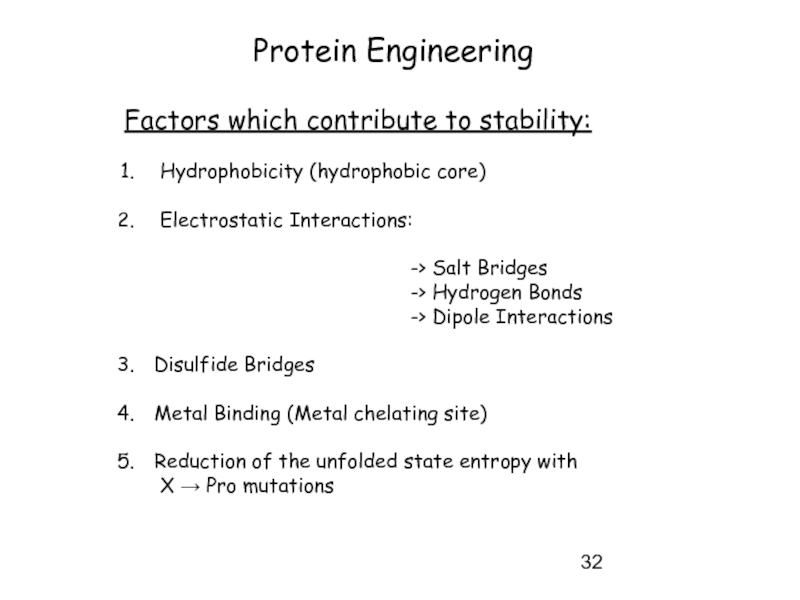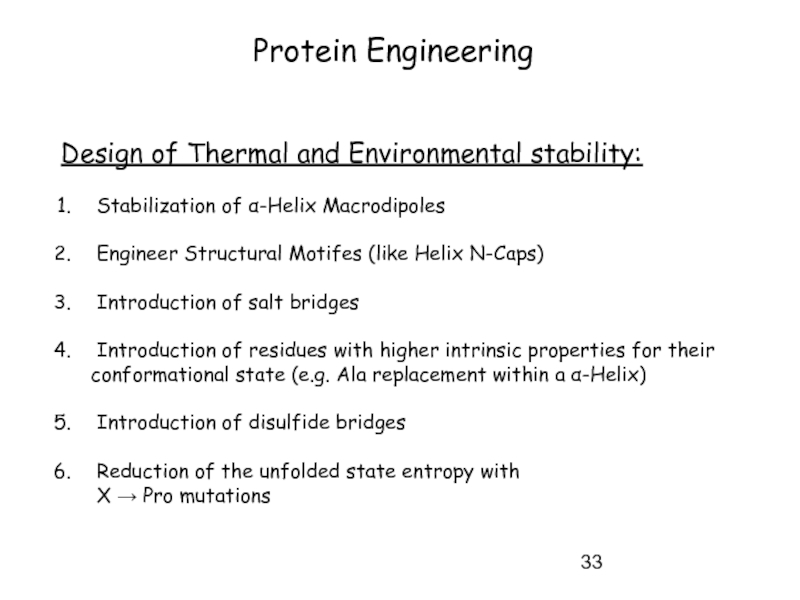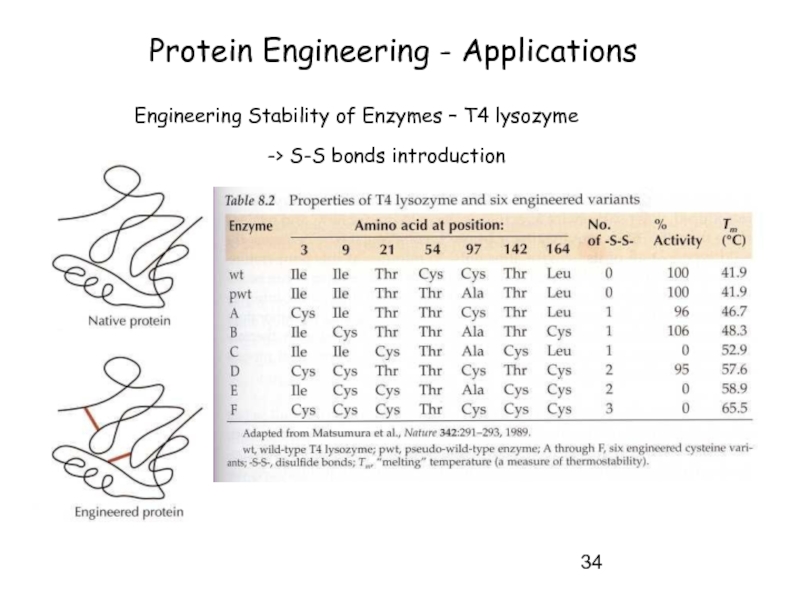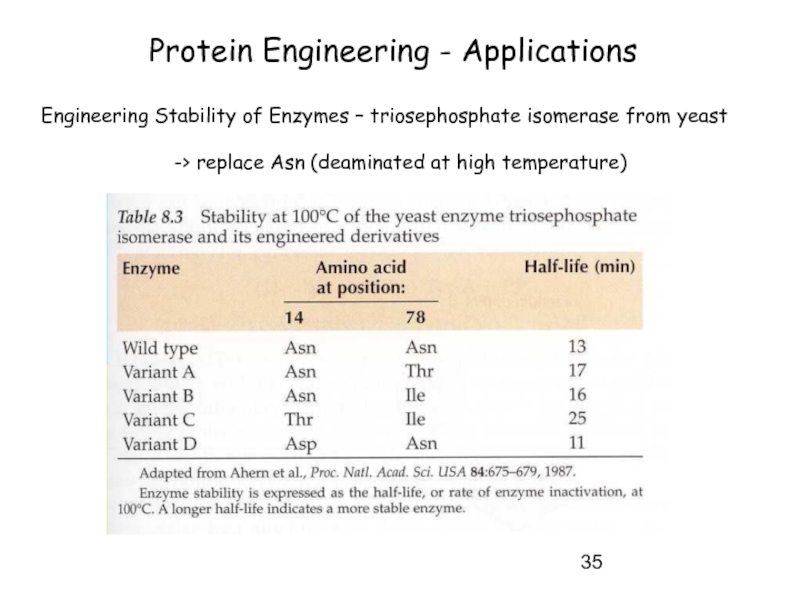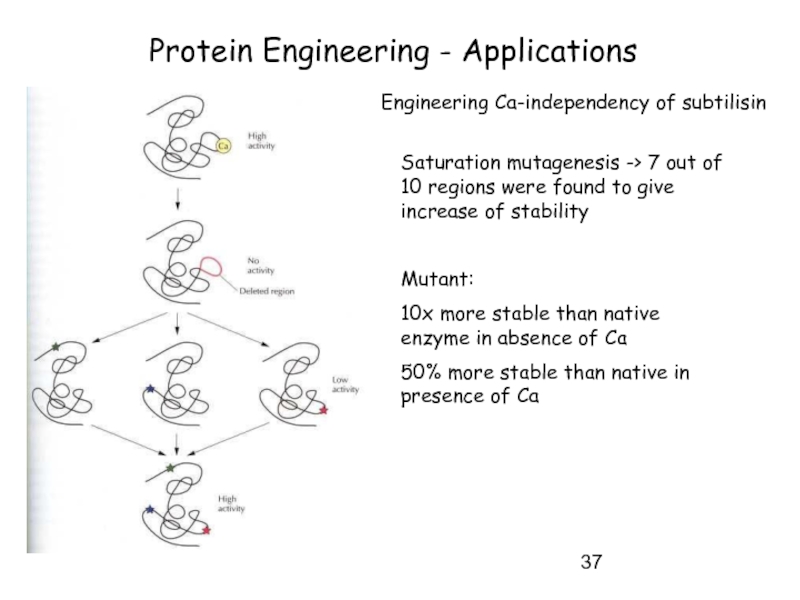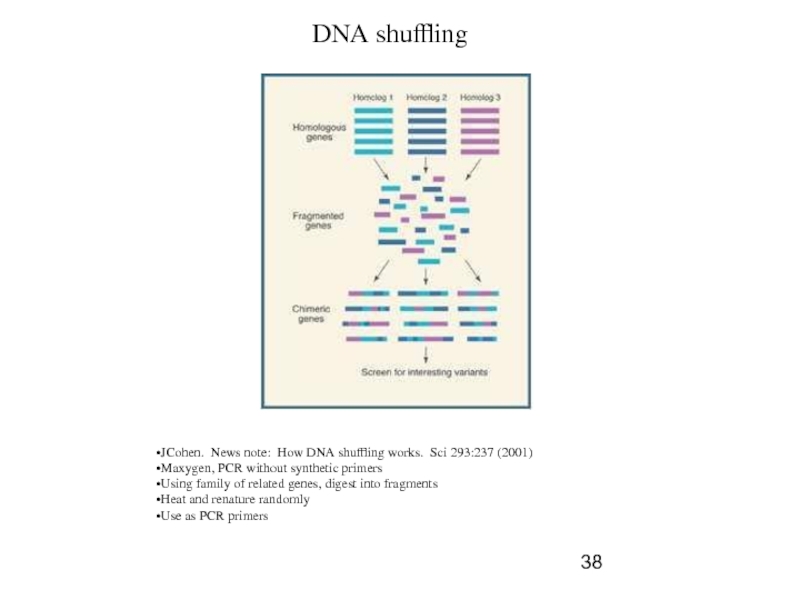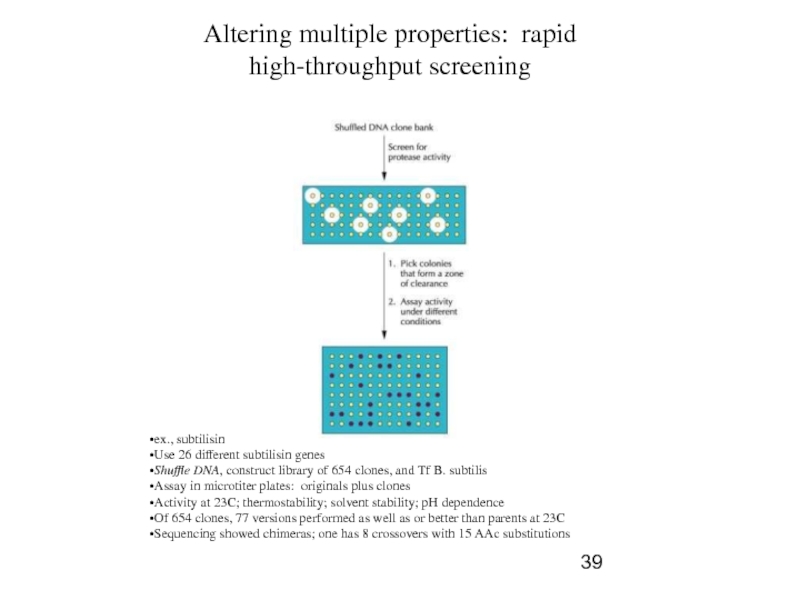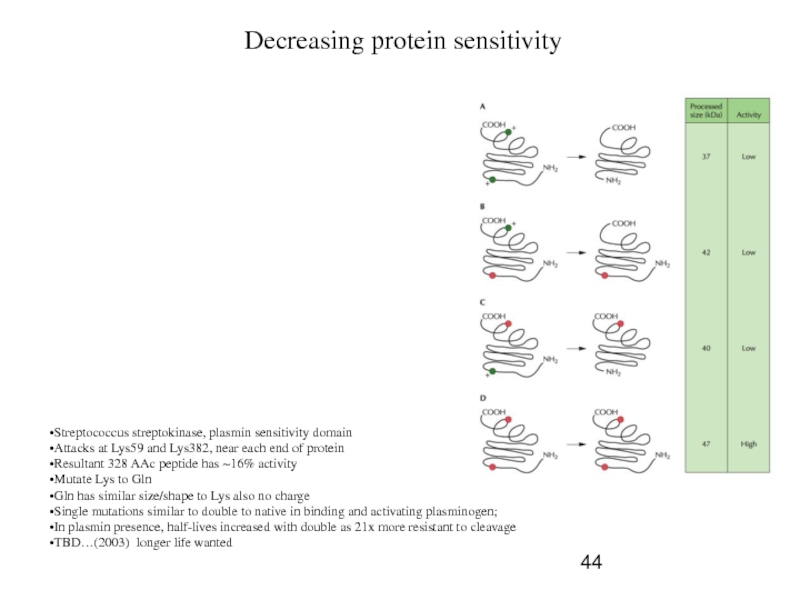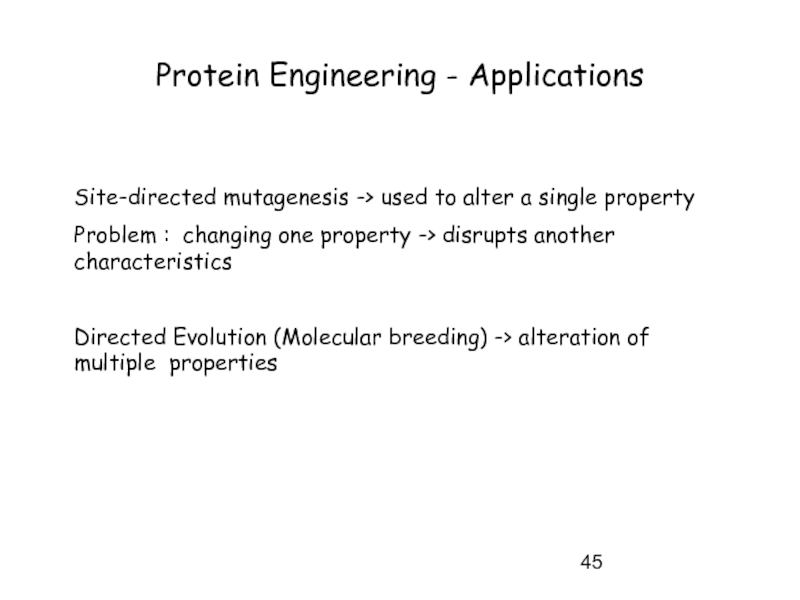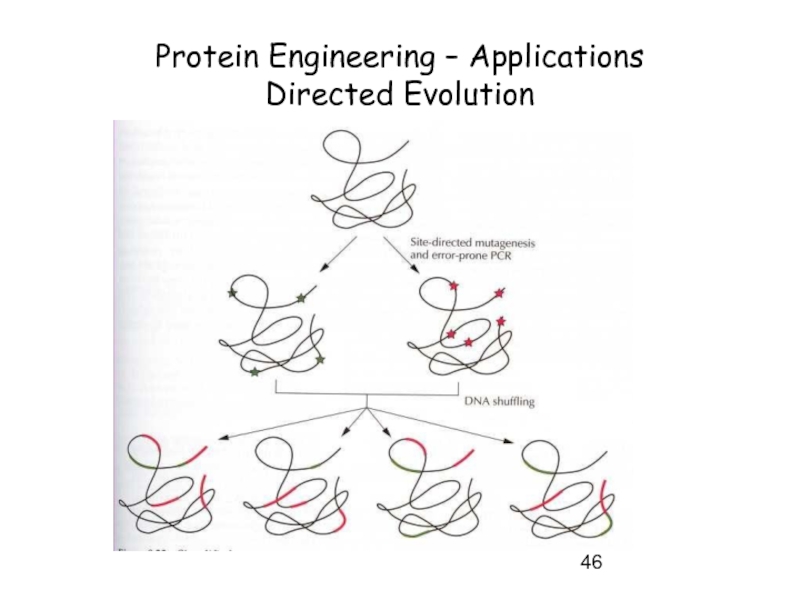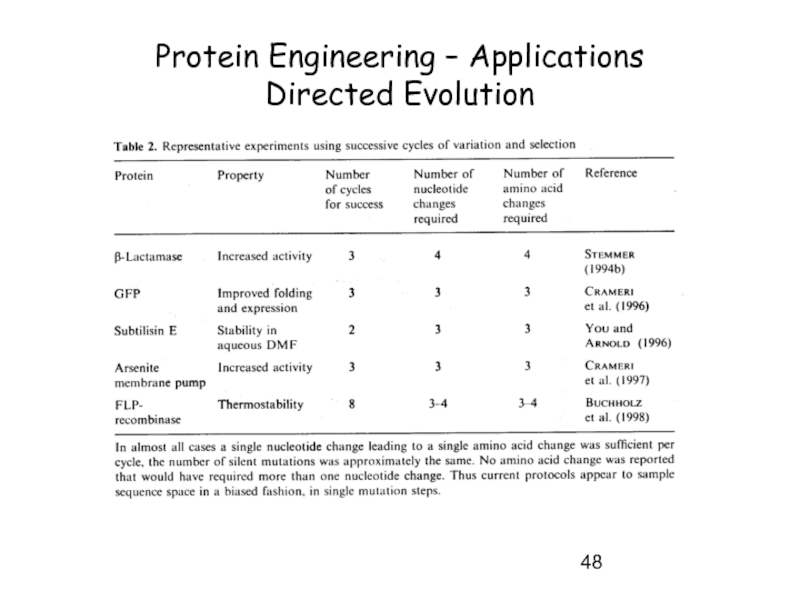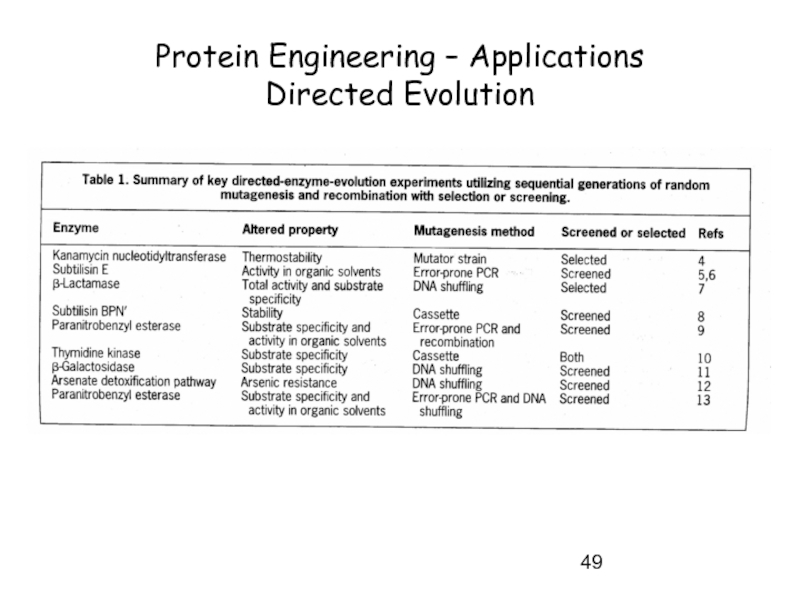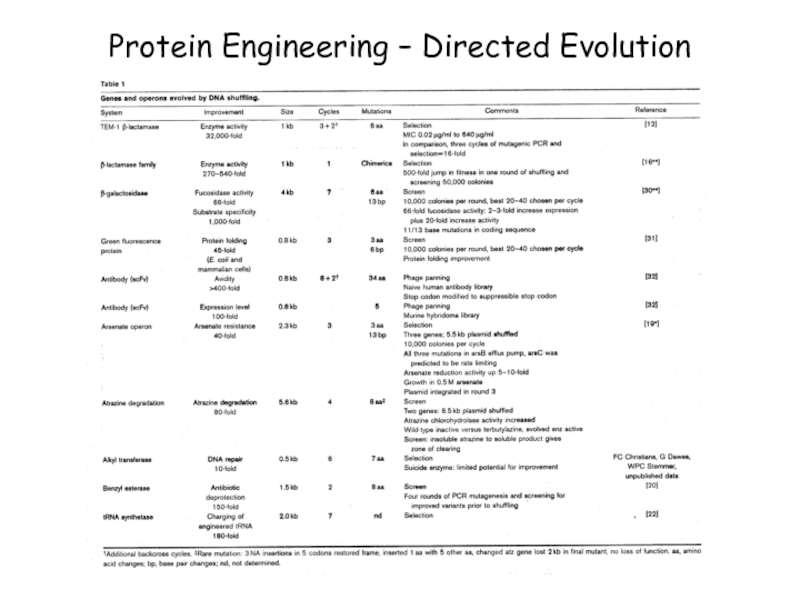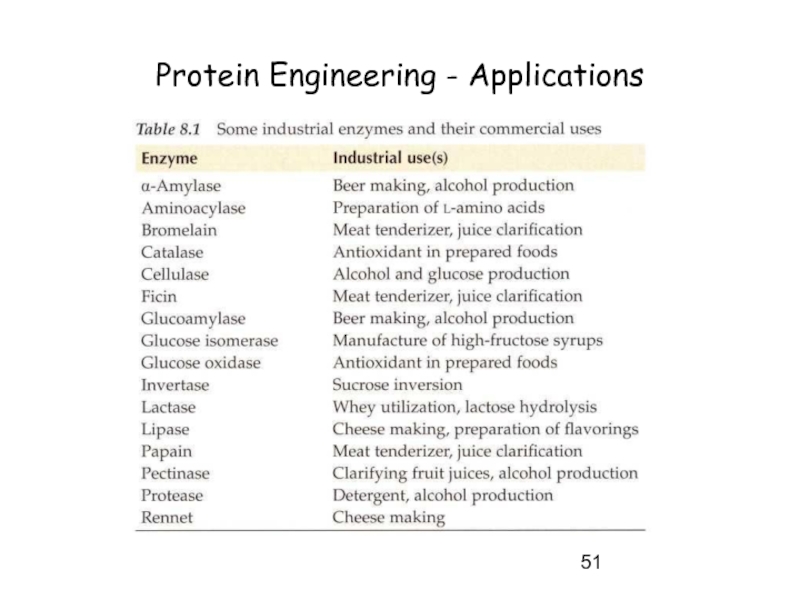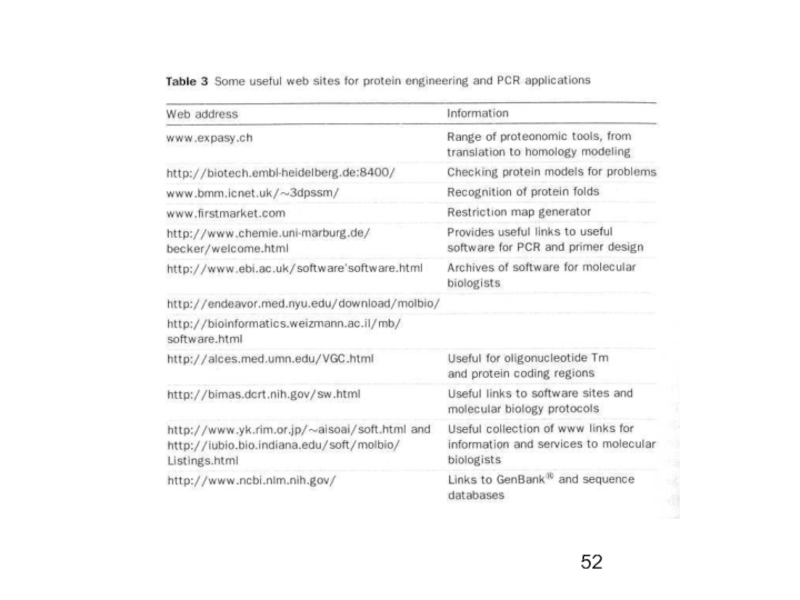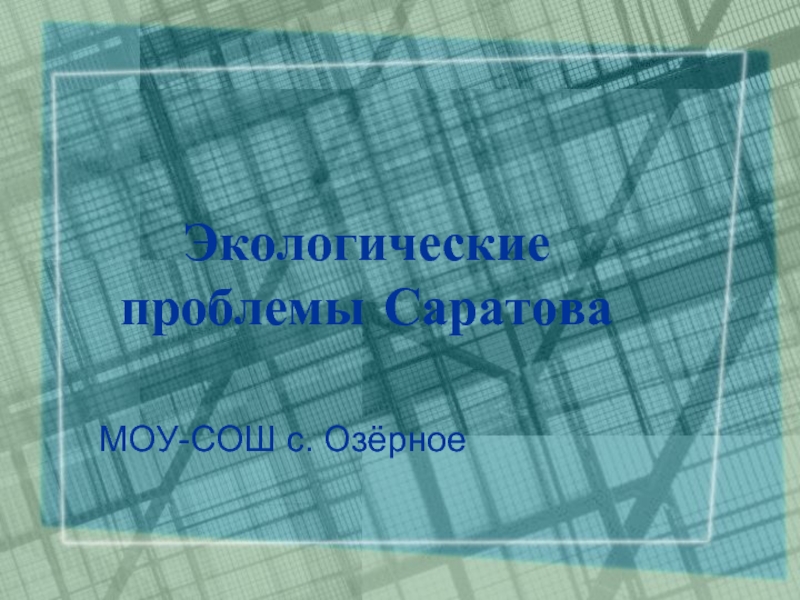- Главная
- Разное
- Дизайн
- Бизнес и предпринимательство
- Аналитика
- Образование
- Развлечения
- Красота и здоровье
- Финансы
- Государство
- Путешествия
- Спорт
- Недвижимость
- Армия
- Графика
- Культурология
- Еда и кулинария
- Лингвистика
- Английский язык
- Астрономия
- Алгебра
- Биология
- География
- Детские презентации
- Информатика
- История
- Литература
- Маркетинг
- Математика
- Медицина
- Менеджмент
- Музыка
- МХК
- Немецкий язык
- ОБЖ
- Обществознание
- Окружающий мир
- Педагогика
- Русский язык
- Технология
- Физика
- Философия
- Химия
- Шаблоны, картинки для презентаций
- Экология
- Экономика
- Юриспруденция
Directed Mutagenesis and Protein Engineering презентация
Содержание
- 1. Directed Mutagenesis and Protein Engineering
- 2. Mutagenesis Mutagenesis -> change in DNA sequence
- 3. Consequences of point mutations within a coding
- 4. Mutagenesis Comparison of cellular and invitro mutagenesis
- 5. Applications of directed mutagenesis
- 6. General strategy for directed mutagenesis Requirements:
- 7. Approaches for directed mutagenesis -> site-directed
- 8. Protein Engineering -> Mutagenesis used for modifying
- 9. Protein Engineering Obtain a protein with improved or new properties
- 10. Rational Protein Design ⇒ Site –directed mutagenesis
- 11. Site-directed mutagenesis methods Old method ->
- 12. Site-directed mutagenesis methods
- 13. Site-directed mutagenesis methods – Oligonucleotide - directed method
- 14. Site-directed mutagenesis methods – PCR based
- 15. Directed Evolution – Random mutagenesis -> based
- 17. General Directed Evolution Procedure Random mutagenesis methods
- 18. Directed Evolution Library Even a large library
- 19. Limitation of Directed Evolution Evolutionary path must
- 20. Successful experiments involve generally less than
- 21. Evolutionary Methods Non-recombinative methods:
- 22. Evolutionary Methods Type of mutation – Fitness
- 23. Random Mutagenesis (PCR based) with degenerated primers (saturation mutagenesis)
- 24. Random Mutagenesis (PCR based) with degenerated primers (saturation mutagenesis)
- 25. Random Mutagenesis (PCR based) Error –prone
- 26. Random Mutagenesis (PCR based) DNA Shuffling
- 27. Random Mutagenesis (PCR based) Family Shuffling
- 28. Random Mutagenesis (PCR based)
- 29. Directed Evolution Difference between non-recombinative and recombinative
- 30. Protein Engineering What can be engineered in
- 31. Protein Engineering What can be engineered in
- 32. Protein Engineering Factors which contribute to
- 33. Protein Engineering Design of Thermal and Environmental
- 34. Protein Engineering - Applications Engineering Stability
- 35. Protein Engineering - Applications Engineering Stability
- 36. Protein Engineering - Applications Engineering Activity
- 37. Protein Engineering - Applications Engineering Ca-independency
- 38. DNA shuffling JCohen. News
- 39. Altering multiple properties: rapid high-throughput
- 40. Laundry, detergent and mushrooms Peroxidase,
- 41. ex., Coprinus cinereus heme peroxidase
- 42. Molecular analysis of hybrid peroxidase
- 43. Decreasing protein sensitivity Streptococcus streptokinase,
- 44. Decreasing protein sensitivity Streptococcus streptokinase,
- 45. Protein Engineering - Applications Site-directed
- 46. Protein Engineering – Applications Directed Evolution
- 47. Protein Engineering – Applications Directed Evolution
- 48. Protein Engineering – Applications Directed Evolution
- 49. Protein Engineering – Applications Directed Evolution
- 50. Protein Engineering – Directed Evolution
- 51. Protein Engineering - Applications
Слайд 2Mutagenesis
Mutagenesis -> change in DNA sequence
-> Point mutations or large
Point mutations (directed mutagenesis):
Substitution: change of one nucleotide (i.e. A-> C)
Insertion: gaining one additional nucleotide
Deletion: loss of one nucleotide
Слайд 3Consequences of point mutations within a coding sequence (gene) for the
Silent mutations:
-> change in nucleotide sequence with no consequences for protein sequence
-> Change of amino acid
-> truncation of protein
-> change of c-terminal part of protein
-> change of c-terminal part of protein
Слайд 6General strategy for directed mutagenesis
Requirements:
DNA of interest (gene or
Expression system must be available -> for testing phenotypic change
Слайд 7Approaches for directed mutagenesis
-> site-directed mutagenesis
result -> library of wild-type and mutated DNA (site-specific)
not really a library -> just 2 species
-> random mutagenesis
-> point mutations in all areas within DNA of interest
result -> library of wild-type and mutated DNA (random)
a real library -> many variants -> screening !!!
if methods efficient -> mostly mutated DNA
Слайд 8Protein Engineering
-> Mutagenesis used for modifying proteins
Replacements on protein level ->
Assumption : Natural sequence can be modified to
improve a certain function of protein
This implies:
Protein is NOT at an optimum for that function
Sequence changes without disruption of the structure
(otherwise it would not fold)
New sequence is not TOO different from the native sequence (otherwise loss in function of protein)
consequence -> introduce point mutations
Слайд 10Rational Protein Design
⇒ Site –directed mutagenesis !!!
Requirements:
-> Knowledge of
(active site,….)
-> Understanding of mechanism
(knowledge about structure – function relationship)
-> Identification of cofactors……..
Слайд 11Site-directed mutagenesis methods
Old method
-> used before oligonucleotide –directed mutagenesis
Limitations:
->
-> randomly mutated
Слайд 15Directed Evolution – Random mutagenesis
-> based on the process of natural
- NO structural information required
- NO understanding of the mechanism required
General Procedure:
Generation of genetic diversity
⇒ Random mutagenesis
Identification of successful variants
⇒ Screening and seletion
Слайд 18Directed Evolution Library
Even a large library -> (108 independent clones)
will
Requirements would be:
20N independend clones -> to have all possible variations in a library
(+ silent mutations)
N….. number of amino acids in the protein
For a small protein: -> Hen egg-white Lysozyme (129 aa; 14.6 kDa)
-> library with 20129 (7x 10168) independent clones
Consequence -> not all modifications possible
-> modifications just along an evolutionary path !!!!
Слайд 19Limitation of Directed Evolution
Evolutionary path must exist - > to be
Screening method must be available
-> You get (exactly) what you ask for!!!
-> need to be done in -> High throughput !!!
Слайд 20Successful experiments involve generally
less than 6 steps (cycles)!!!
Why?
Sequences with improved
2. Capacity of our present methods to generate novel functional sequences is rather limited -> requires huge libraries
⇒ Point Mutations !!!
Typical Directed Evolution Experiment
Слайд 21Evolutionary Methods
Non-recombinative methods:
-> Oligonucleotide Directed Mutagenesis (saturation mutagenesis)
-> Error-prone PCR
Recombinative methods -> Mimic nature’s recombination strategy
Used for: Elimination of neutral and deleterious mutations
-> DNA shuffling
-> Invivo Recombination (Yeast)
-> Random priming recombination, Staggered extention precess (StEP)
-> ITCHY
Слайд 22Evolutionary Methods
Type of mutation – Fitness of mutants
Type of mutations:
Beneficial mutations
Neutral mutations
Deleterious mutations (bad)
Beneficial mutations are diluted with neutral and deleterious ones
!!! Keep the number of mutations low per cycle
-> improve fitness of mutants!!!
Слайд 25Random Mutagenesis (PCR based)
Error –prone PCR
-> PCR with low fidelity
Achieved by:
- Increased Mg2+ concentration
- Addition of Mn2+
- Not equal concentration of the four dNTPs
- Use of dITP
- Increasing amount of Taq polymerase (Polymerase with NO proof reading function)
Слайд 26Random Mutagenesis (PCR based)
DNA Shuffling
DNase I treatment (Fragmentation, 10-50 bp,
Reassembly (PCR without primers, Extension and Recombination)
PCR amplification
Слайд 27Random Mutagenesis (PCR based)
Family Shuffling
Genes coming from the same gene
-> Family shuffling
Слайд 29Directed Evolution
Difference between non-recombinative and recombinative methods
Non-recombinative methods
recombinative methods -> hybrids
Слайд 30Protein Engineering
What can be engineered in Proteins ?
-> Folding (+Structure):
1. Thermodynamic
(Equilibrium between: Native ⇔ Unfolded state)
2. Thermal and Environmental Stability (Temperature, pH, Solvent, Detergents, Salt …..)
Слайд 31Protein Engineering
What can be engineered in Proteins ?
-> Function:
1. Binding (Interaction
How many points are required to bind a molecule with high affinity?
Catalysis (a different form of binding – binding the transition state of a chemical reaction)
Increased binding to the transition state ⇒ increased catalytic rates !!!
Requires: Knowledge of the Catalytic Mechanism !!!
-> engineer Kcat and Km
Слайд 32Protein Engineering
Factors which contribute to stability:
Hydrophobicity (hydrophobic core)
Electrostatic Interactions:
-> Salt Bridges
-> Hydrogen Bonds
-> Dipole Interactions
Disulfide Bridges
Metal Binding (Metal chelating site)
Reduction of the unfolded state entropy with
X → Pro mutations
Слайд 33Protein Engineering
Design of Thermal and Environmental stability:
Stabilization of α-Helix Macrodipoles
Introduction of salt bridges
Introduction of residues with higher intrinsic properties for their conformational state (e.g. Ala replacement within a α-Helix)
Introduction of disulfide bridges
Reduction of the unfolded state entropy with
X → Pro mutations
Слайд 34Protein Engineering - Applications
Engineering Stability of Enzymes – T4 lysozyme
-> S-S
Слайд 35Protein Engineering - Applications
Engineering Stability of Enzymes – triosephosphate isomerase from
-> replace Asn (deaminated at high temperature)
Слайд 36Protein Engineering - Applications
Engineering Activity of Enzymes – tyrosyl-tRNA synthetase from
-> replace Thr 51 (improve affinity for ATP) -> Design
Слайд 37Protein Engineering - Applications
Engineering Ca-independency of subtilisin
Saturation mutagenesis -> 7 out
Mutant:
10x more stable than native enzyme in absence of Ca
50% more stable than native in presence of Ca
Слайд 38
DNA shuffling
JCohen. News note: How DNA shuffling works. Sci
Maxygen, PCR without synthetic primers
Using family of related genes, digest into fragments
Heat and renature randomly
Use as PCR primers
Слайд 39
Altering multiple properties: rapid high-throughput screening
ex., subtilisin
Use 26 different
Shuffle DNA, construct library of 654 clones, and Tf B. subtilis
Assay in microtiter plates: originals plus clones
Activity at 23C; thermostability; solvent stability; pH dependence
Of 654 clones, 77 versions performed as well as or better than parents at 23C
Sequencing showed chimeras; one has 8 crossovers with 15 AAc substitutions
Слайд 40
Laundry, detergent and mushrooms
Peroxidase, ink cap mushroom; dye transfer inhibitor
Wash
high peroxide concentration (inactivates peroxidase)
Random mutagenesis or error-prone PCR, followed by DNA shuffling
One construct had 114x increase in thermal stability, 2.8x increase in oxidative stability
Слайд 41
ex., Coprinus cinereus heme peroxidase (ink cap mushroom); 343 AAc,
Multiple rounds of directed evolution to generate mutant for dye transfer inhibitor in laundry detergent
Native form or WT is rapidly inactivated under laundry conditions at pH 10.5,
50C and high peroxide concentrations (5-10mM)
Combined mutants from site-directed and random mutagenesis led to mutant with
110x thermal stability, 2.8x oxidative stability
Additional in vivo shuffling of pt mutations -> 174x thermal stability and 100x oxidative stability
Cherry…Pedersen. 99. Nat Biotech “Directed evolution of a fungal peroxidase”
Mushroom peroxidase
Слайд 43
Decreasing protein sensitivity
Streptococcus streptokinase, 47 kDa protein that dissolves blood
Complexes with plasminogen to convert to plasmin, which degrades fibrin in clots
Plasmin also degrades streptokinase [feedback loop]
In practice, need to administer streptokinase as a 30-90 min infusion [heart attacks]
A long-lived streptokinase may be administered as a single injection
www-s.med.uiuc.edu; JMorrissey: Med Biochem 10/30/06
Слайд 44
Decreasing protein sensitivity
Streptococcus streptokinase, plasmin sensitivity domain
Attacks at Lys59 and
Resultant 328 AAc peptide has ~16% activity
Mutate Lys to Gln
Gln has similar size/shape to Lys also no charge
Single mutations similar to double to native in binding and activating plasminogen;
In plasmin presence, half-lives increased with double as 21x more resistant to cleavage
TBD…(2003) longer life wanted
Слайд 45Protein Engineering - Applications
Site-directed mutagenesis -> used to alter a single
Problem : changing one property -> disrupts another characteristics
Directed Evolution (Molecular breeding) -> alteration of multiple properties
